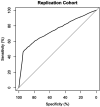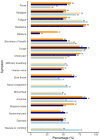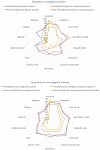This is a preprint.
SARS-CoV-2 (COVID-19) infection in pregnant women: characterization of symptoms and syndromes predictive of disease and severity through real-time, remote participatory epidemiology
- PMID: 32839787
- PMCID: PMC7444306
- DOI: 10.1101/2020.08.17.20161760
SARS-CoV-2 (COVID-19) infection in pregnant women: characterization of symptoms and syndromes predictive of disease and severity through real-time, remote participatory epidemiology
Update in
-
Symptoms and syndromes associated with SARS-CoV-2 infection and severity in pregnant women from two community cohorts.Sci Rep. 2021 Mar 25;11(1):6928. doi: 10.1038/s41598-021-86452-3. Sci Rep. 2021. PMID: 33767292 Free PMC article.
Abstract
Objective: To test whether pregnant and non-pregnant women differ in COVID-19 symptom profile and severity. To extend previous investigations on hospitalized pregnant women to those who did not require hospitalization.
Design: Observational study prospectively collecting longitudinal (smartphone application interface) and cross-sectional (web-based survey) data.
Setting: Community-based self-participatory citizen surveillance in the United Kingdom, Sweden and the United States of America.
Population: Two female community-based cohorts aged 18-44 years. The discovery cohort was drawn from 1,170,315 UK, Sweden and USA women (79 pregnant tested positive) who self-reported status and symptoms longitudinally via smartphone. The replication cohort included 1,344,966 USA women (134 pregnant tested positive) who provided cross-sectional self-reports.
Methods: Pregnant and non-pregnant were compared for frequencies of symptoms and events, including SARS-CoV-2 testing and hospitalization rates. Multivariable regression was used to investigate symptoms severity and comorbidity effects.
Results: Pregnant and non-pregnant women positive for SARS-CoV-2 infection were not different in syndromic severity. Pregnant were more likely to have received testing than non-pregnant, despite reporting fewer symptoms. Pre-existing lung disease was most closely associated with the syndromic severity in pregnant hospitalized women. Heart and kidney diseases and diabetes increased risk. The most frequent symptoms among all non-hospitalized women were anosmia [63% pregnant, 92% non-pregnant] and headache [72%, 62%]. Cardiopulmonary symptoms, including persistent cough [80%] and chest pain [73%], were more frequent among pregnant women who were hospitalized.
Conclusions: Symptom characteristics and severity were comparable among pregnant and non-pregnant women, except for gastrointestinal symptoms. Consistent with observations in non-pregnant populations, lung disease and diabetes were associated with increased risk of more severe SARS-CoV-2 infection during pregnancy.
Keywords: SARS-CoV-2 risk factors; SARS-CoV-2 severity; anosmia; citizen science; community SARS-CoV-2 symptoms; digital health; pregnancy; syndromic surveillance.
Conflict of interest statement
Declaration of interest EM, CMA, WM, JB, MFG, MM have no conflict of interest. ATC previously served as an investigator on a clinical trial of diet and lifestyle using a separate mobile application that was supported by Zoe Global Ltd.
Figures



References
Publication types
Grants and funding
LinkOut - more resources
Full Text Sources
Miscellaneous
